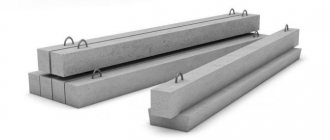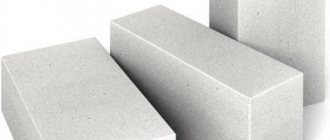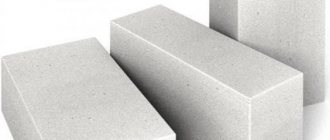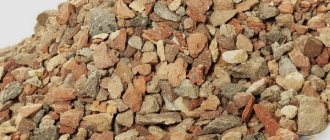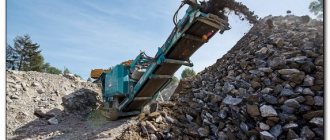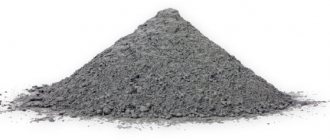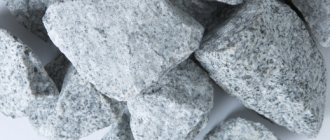Crushed stone belongs to the category of basic building materials. Not a single construction project, small or large-scale, related to any construction industry, can be completed without the use of crushed stone. The production of many building structures in a factory also requires its presence. There are many varieties of this material. Depending on the source raw material, crushed stone can be:
- limestone
- dolomite
- granite
- gravel.
Each of these materials is obtained by crushing a specific rock. So, crushed limestone is made from limestone, dolomite – from dolomite, granite – from granite. But gravel crushed stone is obtained by grinding coarse gravel or crushing rock.
Strength
The main indicator of crushed stone strength is its crushability grade. It shows how resistant the material is to stress. The higher the number, the stronger the material.
The crushability grade of crushed limestone in the Sverdlovsk region ranges from M400 to M1200. It depends on the fraction and place of extraction of the rock. The material can withstand pressure from 0.4 to 100 MPa. For comparison, granite can withstand 90-250 MPa, and gabbro - 200-300 MPa.
Crushed limestone is not the most durable. It cannot be used in critical structures - for the foundations of multi-story buildings, roads with high traffic, engineering structures (bridges, overpasses). But in private construction it is in great demand; it is quite suitable for screeding, the foundation of one-story buildings, and filling paths and courtyards.
What is crushed limestone used for?
This type is in demand in various fields; it is a folk stone material. Its characteristics are suitable for performing tasks in various areas.
Here we list the places where crushed limestone is used:
- pouring the foundations of private houses and buildings;
- construction and repair of secondary roads;
- laying pedestrian areas, sidewalks, paths;
- drainage systems;
- dry mixes;
- reinforced concrete products;
- bedding for tram roads;
- design of flower beds, flower beds;
- landscape work in parks and the private sector;
- production of concrete solutions;
- lime production.
Expert's comment - the right type of limestone - crushed stone will ultimately give a positive result.
Abrasion
Even the most durable stone will wear out over time if cars or pedestrians walk on it. We can notice this on old steps and paving slabs. How susceptible crushed stone is to abrasion can be determined by spinning it in a drum together with iron balls.
After the test, the crumbled particles are separated, the weight loss is determined and a grade is assigned:
- I1 - weight loss by 25%
- I2 - by 25-35%
- I3 - by 35-45%
- I4 - by 45-60%
The abrasion of crushed limestone depends on its strength. Most often it has the value I2-I3. This means that the coatings will wear out much faster than when using granite or diorite crushed stone.
Frost resistance
In temperate and northern latitudes, stone buildings are destroyed much faster than in the south. This is due to temperature changes in winter. Water fills the pores and small cracks in the stones, freezes and expands. Over time, the volume of cracks increases until they become visible or the stone splits.
To determine frost resistance, samples are repeatedly frozen and thawed. The number of cycles that the crushed stone can withstand is recorded. Since limestone has a porous structure and relatively low strength, it is not very resistant to temperature changes. The material can withstand from 50 to 200 cycles (from 10 to 50 winters). The higher the crushability grade, the better the frost resistance.
Is it possible to use crushed limestone for a foundation?
Due to low strength indicators, it is not used for foundations in multi-story construction; expensive types of stone are in demand there - granite or gravel.
Limestone for foundations is in demand in private households when building light structures.
Expert advice - the best option would be crushed stone with flakiness values no higher than 10. Cuboidal grain will create a dense concrete mass, without voids.
You should also take into account the frost resistance indicator, it should be at least F 300.
The optimal fraction for such work is 20 - 40 mm.
Taking into account these recommendations, you can build a reliable foundation for the construction of a low building in a private house or cottage.
We recommend that you familiarize yourself with one more topic: Is it possible to make a foundation in late autumn?
Flakiness
The optimal shape of crushed stone is cuboid. But when crushing rock, some grains turn out flat or flaky. The more such particles, the lower the strength and higher the water permeability of the material.
There are 5 groups of flakiness. They are determined by the percentage of irregularly shaped grains. Limestone crushed stone from the Sverdlovsk region belongs to the first and third groups, it contains 9, 82% and 25% of flaky particles. The indicator is lower for materials with greater strength.
Crushed stone with low flakiness is suitable for making concrete. It is better to buy material from the third group for drainage.
How to distinguish different types of crushed stone
Not every specialist, much less a layman, can visually distinguish different types of aggregates. To determine the difference between materials, you need to know their properties. The main characteristics of crushed material are:
- compressive strength, this indicator indicates the grade of crushed stone;
- density, average value ranges from 1.4 to 3 g/cm3;
- fractions, crushed stone is sorted by grain size after sifting through sieves with different cell sizes;
- flakiness, this indicator determines the percentage of flat and needle-shaped illiquid grains in the total mass; The most suitable for construction work is the cube-shaped form of crushed stone;
- frost resistance is a very important indicator, especially in road construction; indicates the number of freezing and thawing cycles;
- Based on radioactivity, crushed stone is divided into two classes, the first is suitable for all kinds of work, the second - only for roads.
What is the difference between dolomite and limestone crushed stone? Dolomite rock in its strength characteristics is between limestone and granite. Therefore, dolomite crushed stone is stronger than limestone, and its area of use is somewhat wider. While limestone aggregates are recommended mainly for road construction, dolomite materials are used in the production of reinforced concrete products, as well as for decorative purposes.
The easiest way is to find the differences between granite and limestone crushed stone. They can be distinguished even by their appearance. Granite crushed stone has a reddish tint, while limestone crushed stone is most often white, gray, yellow or brown with a whitish coating. Crushed material from granite rocks belongs to the high-strength category. Therefore, it is used for the production of prefabricated and monolithic reinforced concrete, including prestressed concrete. The most popular fraction is 5-20 mm.
Crushed stone, obtained by grinding and sifting coarse gravel or rock stones, is close in strength to granite. How to distinguish crushed gravel from limestone? Based on external signs, round gravel pebbles may be found among the total mass of gravel material. In addition, it is much harder and more durable than limestone.
Water absorption
Water absorption refers to the ability of crushed stone to absorb moisture when left in water for a long time. The indicator depends on the density of the rock, the size, number and configuration of pores. It is also affected by the size of the fraction. The smaller it is, the greater the surface area for absorbing liquid.
The porosity of limestone is high, ranging from 0.36-27%. Therefore, the water absorption coefficient of crushed stone from this rock ranges from 0.5% to 40%. It shows how much the mass of the sample increases after soaking in water for two days. If a material with high performance is used in a concrete solution, water consumption will be high, which affects the strength.
Main directions of use of crushed stone
Cuboid crushed stone is considered the most popular, because the stones in it are the same in shape and size. Therefore, when filling, it almost does not form voids (flakiness index < 10%), it is consumed more economically and, due to good compaction, it becomes stronger in use.
The less flakiness, the higher quality the material. The maximum rate is 11%. Low flakiness of crushed stone crushed in a rotary crusher rather than in a cone crusher.
| How crushed stone is used | Description |
| Filler | Add during mixing:
Used for silicate, cellular blocks with autoclave curing. Limestone has good adhesion to cement, so the concrete is dense and provides a monolithic coating |
| Landscaping |
|
| Base |
Limestone foundations require good waterproofing (ring drainage). The pillow must be above the groundwater level, because limestone is destroyed by continuous contact with moisture |
| Facing | Finish the walls of buildings as facing stones |
| Drainage |
|
| In the chemical industry | For fertilizers, obtain lime |
Crushed stone with a compaction coefficient of 1.01–1.52 tons/cubic meter is suitable for road construction. This is true for both highway cushions and ordinary sidewalks.
Limestone crushed stone is used as a cushion for the foundation
Options for using limestone in landscape design
Water resistance
Some types of limestone soften when exposed to water and lose their structure. These include, for example, materials containing gypsum. This occurs due to the dissolution of salts, the loss of chemical bonds between different elements. Crushed stone from this rock cannot be used in places with high humidity.
Limestone crushed stone from the Sverdlovsk region is relatively. Its softening coefficient is 0.35-0.37 (with a norm of 0.7). However, with prolonged contact with water, such material collapses much faster than, for example, granite or diorite crushed stone.
Compound
To classify crushed stone, it is necessary to take into account its characteristics. These characteristics include: crushed stone size, composition, bulk density of crushed stone, density and thermal conductivity.
There are several types of crushed stone. The following materials are mainly used in construction: granite, slag, limestone and gravel.
Slag
A higher quality and more reliable material is considered to be one that contains a small percentage of weak rocks. Let us remember that crushed stone is obtained by grinding natural materials.
It is not uncommon to reuse the material, for example, after recycling brick or old asphalt.
Such crushed stone is called secondary . This method is cheaper, but of lower quality.
Secondary
The uniformity of crushed stone has the greatest influence on its quality. Due to this, the density of the product used increases. Also important is tolerance and resistance to natural factors such as frost and rain.
We should not forget about the degree of radioactivity, to which special attention must be paid, since it affects human health.
Content of dust and clay particles
When rock is mined and crushed, small clay and dust grains with a diameter of up to 0.05 mm can get into the crushed stone. They impair the adhesion of the material to binders, absorb water and swell, causing frost heaving. When making concrete, you will have to add more water, which affects its strength. Therefore, the content of small impurities is strictly regulated by GOST; they should not exceed 1%.
In limestone crushed stone of the Sverdlovsk region, the amount of clay and dust grains is 0.2-1.5%. In some materials it exceeds the norm, but only slightly. Therefore, the indicator does not affect the quality.
Use of crushed stone by fractions
The fraction of crushed stone affects the scope of its application.
| Fraction, mm | Application |
| 5–20 |
|
| 20–40 |
|
| 40–70 |
|
| 70–120 | pour pillows under the foundations of large objects |
The fraction larger than 70 mm are non-standard grains; most often they are ground or used as rubble stone. For example, for the construction of fences, gabions.

